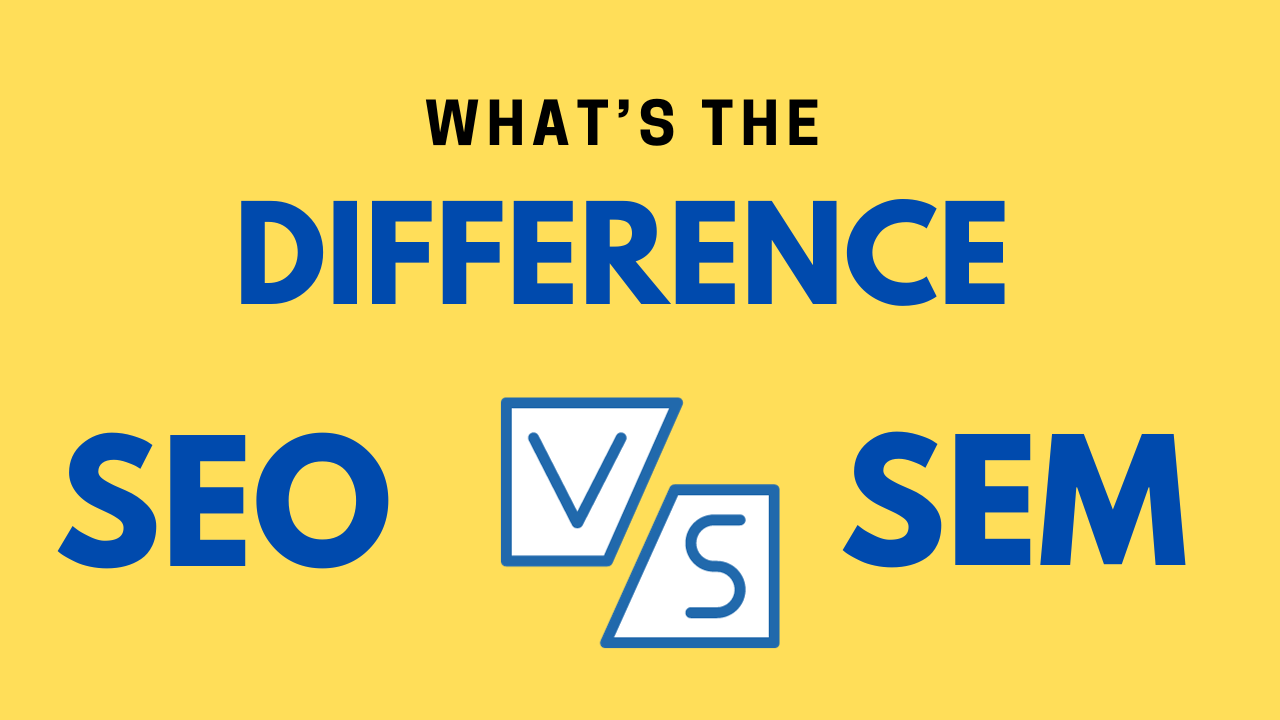SEO vs SEM: What’s the difference?

Table of Contents
SEO vs SEM
In digital marketing, two terms often come into play: SEO and SEM. While they may sound similar, SEO stands for “search engine optimization,” it’s about making a website more accessible to find on search engines like Google. SEM refers to “search engine marketing,” and it’s like paying to appear at the top of search results. Both SEO and SEM can help businesses get more visitors to their websites.
To truly understand the main difference between SEO and SEM, it’s essential to acknowledge that Google’s search outcomes fall into two main categories.
- Organic Traffic (SEO)
- Paid Traffic (SEM)
SEO: Search Engine Optimization
SEO, commonly known as Search Engine Optimization, refers to optimizing a website’s elements and structure to improve its position in organic search results. This process involves various techniques, including keyword research, content creation, on-page optimization, and backlink building. By implementing these strategies, businesses aim to enhance their website’s relevance and authority and achieve higher rankings in Search Engine Results Pages (SERPs). SEO is mainly divided into three main areas.

On-Page SEO: On-Page SEO refers to optimizing the website content on your website to improve its ranking. This process involves many techniques, such as adding title tags, ALT tags, and Meta tags to your content.
- It also includes creating blog posts and optimizing other elements of your website, such as header tags, internal links, and image optimization.
- The most powerful advantage of On-page SEO is that you have complete control over it, which means you can change your website content and structure to increase its visibility and ranking in search engines.
- By implementing effective On-page SEO strategies, you can increase your website’s traffic, improve user experience, and drive more conversions and revenue for your business.
Off-Page SEO: Off-page SEO, also referred to as Off-Site Search Engine Optimization, is a vital aspect of SEO that involves optimizing your online presence outside your website. Unlike on-page SEO, which deals with optimizing your website, off-page SEO focuses on building relationships with other websites, creating high-quality backlinks, improving social media profiles, and sharing valuable content that appeals to your target audience.
Off-page SEO is an essential strategy for improving your website’s search engine ranking, increasing visibility, driving traffic, and, ultimately, achieving business goals.
- By building quality backlinks from reputable websites, you can signal to search engines that your website is trustworthy and authoritative,
- Improve your domain authority and increase your chances of ranking higher in search results.
- Off-page SEO also involves social media optimization, which entails creating and optimizing social media profiles for your business.
- By using social media platforms like Facebook, Twitter, LinkedIn, and Instagram, you can engage with potential customers, increase brand awareness, and drive traffic to your website.
Overall, off-page SEO is a vital part of any successful SEO strategy, and businesses that invest in it can reap the benefits of increased visibility, credibility, and traffic.
Technical SEO: When it comes to technical SEO, it’s all about providing your website with a technical upgrade that makes it easier for search engines like Google to move around and understand your site’s content better.
- This optimization involves technical aspects such as improving website speed, fixing broken links, and enhancing the overall user experience.
- Optimizing image sizes, compressing large files, and utilizing caching are ways to speed up your pages and improve the website’s performance.
- Additionally, seamless internal linking within your website can help search engines identify your site’s most critical pages and better understand your content’s hierarchy.
Implementing these technical SEO practices can increase your website’s visibility and improve your rankings on search engine results pages.
SEM: Search Engine Marketing
Search engine marketing (SEM) is a strategy that involves various paid advertising techniques to gain visibility on search engines. Unlike SEO, SEM primarily involves pay-per-click (PPC) advertising, where businesses spend to show their ads at the top of search engine results. This advertising model charges the company only when a user clicks on their ad, and the cost is paid to the search engine platform, such as Google.

SEM offers businesses immediate visibility and a quicker route to reach their targeted audience more effectively. It also provides various targeting options, including location, demographics, and specific search queries. With SEM, businesses can also measure the performance of their ads, including impressions, clicks, conversions, and return on investment (ROI), making it easier to optimize campaigns and improve results.
Businesses can significantly improve their revenue by using SEM, increasing their online visibility and attracting more website traffic.
Key Differences: A Close Analysis
To fully understand the critical differences between Search Engine Optimization and SEM, let’s discuss their Goal, Methods, Traffic, Results, and Cost.
Goal: SEO aims to improve a website’s organic ranking in search results, while SEM focuses on acquiring paid ad placements.
Methods: SEO employs keyword research, on-page optimization, and link building, while SEM utilizes PPC advertising to purchase ad placements.
Traffic: SEO generates unpaid (organic) traffic, while SEM attracts paid (PPC) traffic.
Results: SEO results take time to bring traffic (sometimes it may take 6 to 12 months to get results), while SEM results are immediate and can bring you quick revenue and traffic.
Cost: SEO is generally free, while SEM can be costly depending on the ad campaigns and keywords.
Choosing the Right Approach
When deciding whether to invest in SEO or SEM, businesses must consider their unique objectives, financial resources, and timeline. For those looking to establish a solid and lasting online presence, SEO can be an effective long-term strategy to achieve organic growth. On the other hand, if a business needs to generate visibility and run targeted ad campaigns quickly, SEM can provide a solid and immediate solution. The key is to carefully weigh the pros and cons of each approach based on your business’s specific needs and goals.
While SEO and SEM operate independently, they can also work collaboratively to increase the website’s visibility. SEO can improve the quality and relevance of a website’s content, making it more attractive to organic and paid traffic. Alternatively, SEM can drive immediate traffic to a website, indirectly boosting its organic ranking by increasing user engagement and metrics like time on site.
Summary
SEO and SEM are the two most popular and versatile methods in digital marketing. Businesses can leverage to achieve their marketing goals and improve their online presence. With SEO, companies can focus on organic growth by optimizing their website and content to improve search engine rankings, attract more traffic, and enhance brand visibility over time.
On the other hand, SEM offers a more immediate approach to online marketing by using paid advertising to reach a specific audience and drive traffic to a website or landing page. Whether businesses are looking for long-term growth or short-term results, SEO and SEM provide the means to succeed in the ever-evolving digital marketplace.
